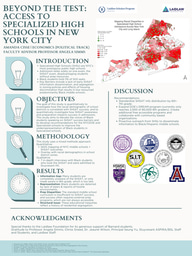Current Stage of Research: Abstract
In predominantly Black and Hispanic neighborhoods, fewer than 1 in 10 SHSAT test takers receive an offer to a Specialized High School. These nine elite public schools are academically rigorous, receive more public funding, and are governed by the Hecht-Calandra Act of 1971. From early ages, students in New York City are zoned into schools based on where they live. In lower-income districts, schools are often underfunded and lack resources, limiting access for low-income and Black students to NYC’s top public high schools. This paper examines how school-level policies and systemic disparities contribute to limited information, resources, and preparation for Specialized High School admissions in underserved communities. Using a sociological framework, I consider racial residential segregation, zoning policies, and educational segregation history in the U.S., to better understand the racial disparities in SHSAT outcomes. Taking a mixed-methods approach, I survey middle and high school administrators using a Likert scale and open-ended interviews to explore how differences in school outreach, availability of free or low-cost test preparation, and dissemination of information shape the high school admissions process.

Please sign in
If you are a registered user on Laidlaw Scholars Network, please sign in